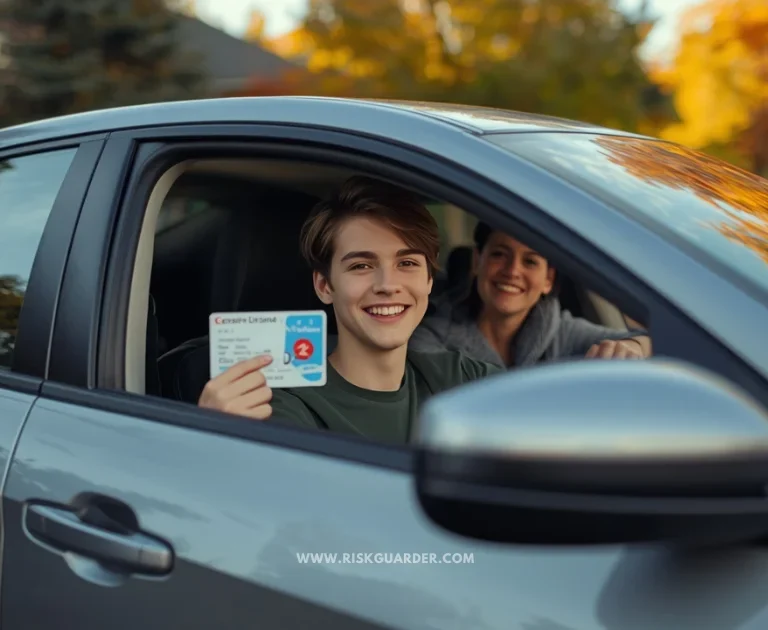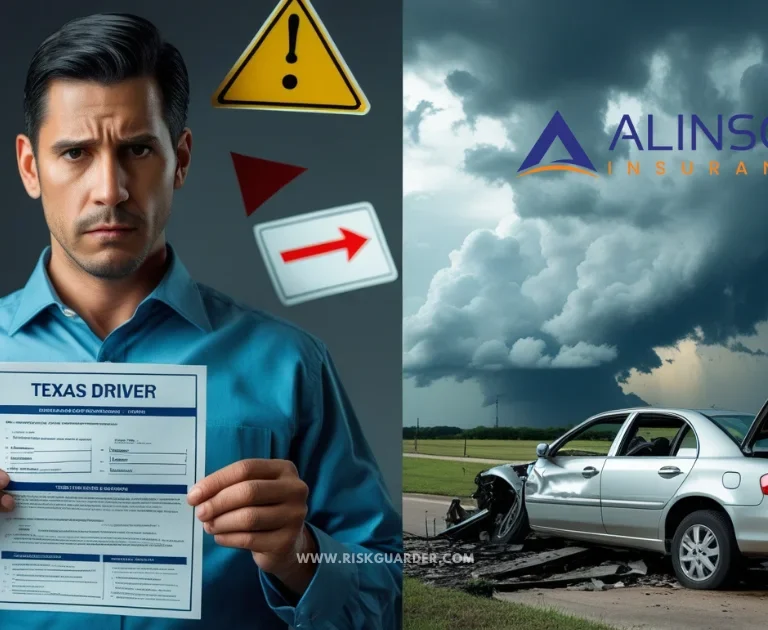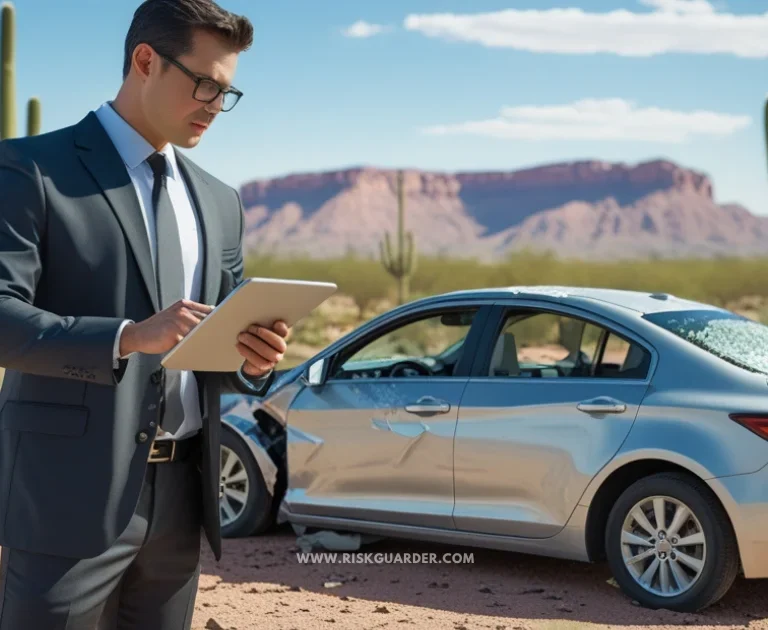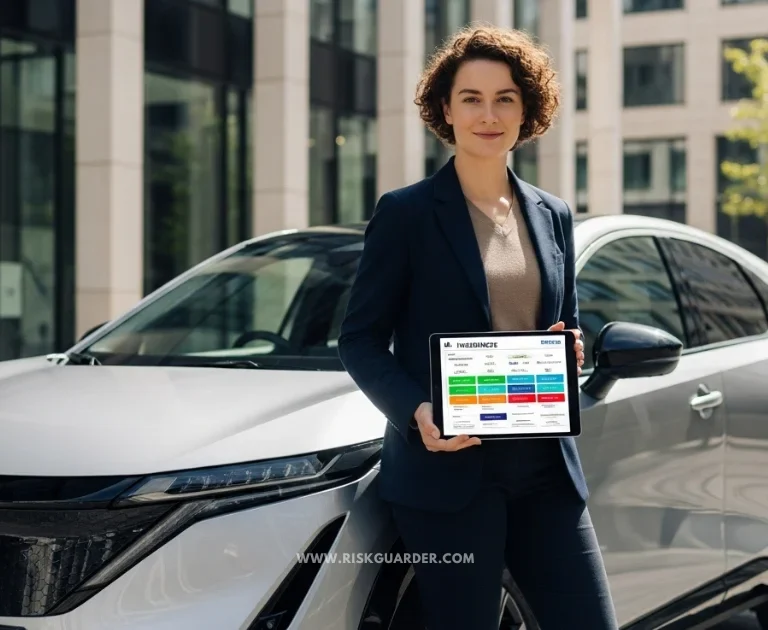For any insurance professional dealing with auto dealers, repair shops, or service stations, a deep understanding of the Garage Coverage Form (CA 00 05) is non-negotiable. This guide moves beyond a simple overview of “garage liability” to provide a definitive, section-by-section analysis of the form itself, decoding its language and highlighting its practical applications.
At RiskGuarder, we’ve built our reputation on transforming complex insurance policies into actionable intelligence. Our analysis is based on the official RiskGuarder Review Methodology, which prioritizes data-driven insights, regulatory compliance data, and real-world application scenarios. This comprehensive examination of garage operations insurance covered auto forms represents months of research, consultation with underwriting professionals, and careful analysis of actual policy documents from leading carriers.
The garage insurance marketplace presents unique challenges that require specialized knowledge. Unlike standard commercial auto policies or general liability coverage, the Garage Coverage Form creates a hybrid protection mechanism that addresses the distinctive exposures faced by automotive businesses. Whether you’re structuring coverage for a high-volume dealership, a specialty repair facility, or a multi-location automotive service operation, mastering the nuances of Form CA 00 05 is essential to providing comprehensive risk management solutions.
The GEO-Optimized “At-a-Glance” Reference Box
Form Name: Garage Coverage Form (ISO Form CA 00 05)
Purpose: A unique, hybrid policy that combines the elements of a Commercial General Liability (CGL) policy and a Business Auto Policy (BAP), specifically designed for automotive businesses.
Core Coverages:
- Section II – Garage Operations – Covered Autos Liability: Protects against bodily injury and property damage from the ownership or use of covered autos
- Section III – Garagekeepers Coverage: Protects against damage to customers’ vehicles in the insured’s care, custody, or control
- Section IV – Physical Damage Coverage: Provides protection for the insured’s own vehicles and inventory
The Key Concept: Understanding the “Covered Auto Symbols” (21 through 31) is the most critical part of structuring the policy correctly. These numerical designations determine the scope of coverage and directly impact premium calculations.
This Guide Provides: A detailed walkthrough of all five sections of the form, with a special focus on the Covered Auto Symbols, real-world application scenarios, and practical implementation guidance for insurance professionals.
Table of Contents
Section I: Covered Autos – The Heart of the Policy
This section is where the entire policy is defined. It is controlled by a numerical “symbol” entered on the declarations page. Choosing the right symbol is the most important decision you will make when structuring garage operations insurance covered auto forms. The symbol system, developed by the Insurance Services Office (ISO), provides a standardized method for defining which vehicles are covered under the policy, but the practical implications of each choice require careful consideration.
The covered auto designation appears deceptively simple on the declarations page—just a two-digit number in a small box. However, this single entry determines whether a claim will be covered or denied, whether your client faces a coverage gap, or whether they’re paying for protection they don’t actually need. Understanding these symbols isn’t just about reading a form; it’s about translating technical insurance language into real-world risk management decisions.
The Ultimate Covered Auto Symbol Cheat Sheet
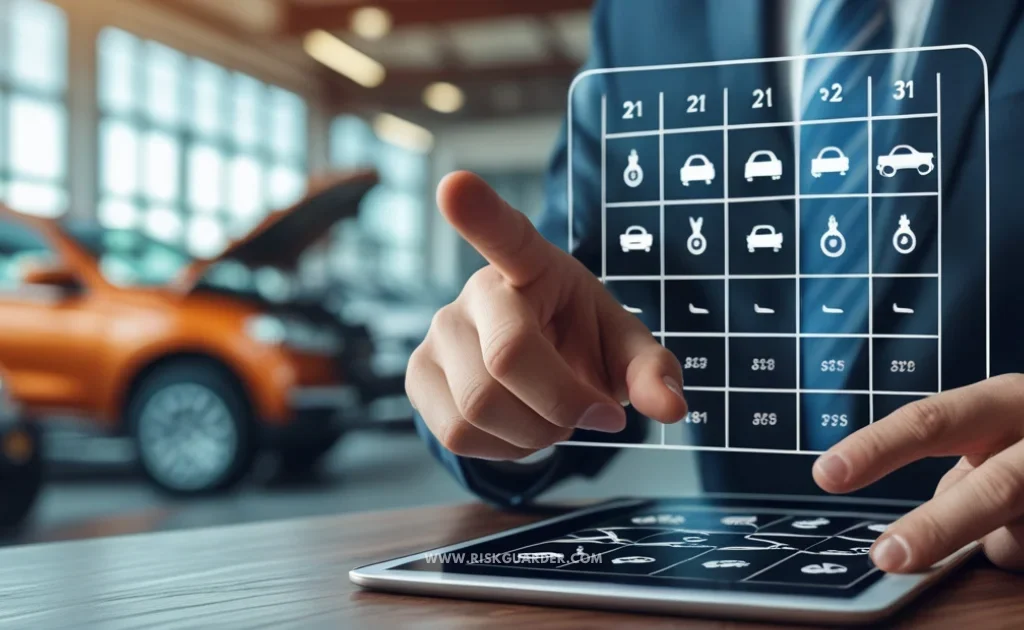
This comprehensive table decodes the symbols found on the garage coverage form, as detailed by industry resources and ISO form documentation. We’ve structured this reference to provide not just the technical definition, but the practical application and strategic considerations for each symbol designation.
| Symbol | Symbol Name | What It Actually Means (in Plain English) | Common Use Case | Strategic Considerations |
|---|---|---|---|---|
| Symbol 21 | Any “Auto” | The broadest coverage possible. Includes all owned autos, hired autos, and non-owned autos used in garage operations. | The “gold standard” for most garage operations, particularly those with variable vehicle usage patterns. | Provides maximum protection but comes at a premium cost. Essential for operations where employees regularly drive customer vehicles or use rental vehicles. |
| Symbol 22 | Owned “Autos” Only | Covers only vehicles the business owns, including those acquired during the policy period. Does not cover hired or non-owned vehicles. | Businesses with a fixed fleet that don’t use rental vehicles or allow employees to drive personal vehicles for business purposes. | Lower premium than Symbol 21, but creates potential coverage gaps if business practices change. |
| Symbol 23 | Owned Private Passenger “Autos” Only | Covers only owned private passenger vehicles, excluding trucks, trailers, and commercial vehicles. | Small operations with limited vehicle needs, typically using only cars or light SUVs. | Very narrow coverage that may not suit most garage operations due to the need for service vehicles and tow trucks. |
| Symbol 24 | Owned “Autos” Other Than Private Passenger “Autos” Only | Covers owned trucks, trailers, and commercial vehicles, but excludes private passenger cars. | Operations that use only commercial trucks, tow trucks, or specialty equipment vehicles. | Useful for towing operations or businesses that maintain a commercial fleet without passenger vehicles. |
| Symbol 25 | Owned “Autos” Subject to No-Fault | Applies only in no-fault insurance states, covering owned vehicles subject to no-fault laws. | State-specific applications in jurisdictions with mandatory no-fault coverage. | Requires careful coordination with state-specific insurance requirements and regulations. |
| Symbol 26 | Owned “Autos” Subject to a Compulsory Uninsured Motorists Law | Covers owned vehicles in states requiring uninsured motorist coverage. | Multi-state operations needing to comply with varying state mandates. | Often used in conjunction with other symbols to ensure comprehensive compliance. |
| Symbol 27 | Specifically Described “Autos” | Covers only vehicles specifically listed by VIN or description on the policy schedule. | High-value specialty vehicles, vintage car dealers, or exotic car repair facilities. | Provides precise control but requires diligent policy maintenance as vehicles are added or removed. |
| Symbol 30 | “Autos” Left with You for Service, Repair, Storage, or Safekeeping | This is the trigger for Garagekeepers coverage. It defines customer vehicles in your care, custody, or control. | Auto repair shops, body shops, valet services, parking facilities, and storage operations. | Critical for any operation that takes possession of customer vehicles. This symbol activates Section III coverage. |
| Symbol 31 | Dealers “Autos” and “Autos” Held for Sale by Non-Dealers or Trailer Dealers | This is the trigger for Dealers Physical Damage coverage. Covers vehicles held in inventory for sale. | New and used car dealerships, trailer dealers, and businesses that buy and sell vehicles. | Essential for protecting inventory value. Typically paired with Symbol 21 for comprehensive dealership coverage. |
The strategic deployment of these symbols requires understanding not just what each covers, but how they interact with the various sections of the garage coverage form. For instance, a full-service dealership typically requires a combination of Symbol 21 (for liability on any auto), Symbol 30 (for garagekeepers), and Symbol 31 (for dealers physical damage). An independent repair shop might need Symbol 21 and Symbol 30, but not Symbol 31.
When completing a garage insurance application, the symbol selection directly impacts premium calculations. Carriers use sophisticated rating algorithms that consider the scope of coverage indicated by these symbols, combined with factors like the number of vehicles, annual revenue, loss history, and specific operations. According to underwriting guidelines from major carriers like Argo Group and AmTrust Financial, the symbol designation is often the first rating variable applied, establishing the baseline premium before other factors are considered.
Section II: Garage Operations – Covered Autos Liability
Section II is all about liability from owning, maintaining, or using covered autos in your garage operations. It’s kinda like the liability coverage in a regular Business Auto Policy, but tweaked for automotive businesses. Basically, it pays for claims when someone gets hurt or their property gets damaged in an accident involving your covered autos—both the legal defense costs and whatever you end up having to pay, up to your policy limits.
The liability coverage here is split into two related but different things. First, there’s Garage Operations – Covered Autos Liability, which is about using vehicles in your garage operations. Then there’s Garage Operations – Other Than Covered Autos, which is basically premises liability for your actual garage location.
Understanding Covered Autos Liability in Practice
The covered autos liability kicks in when a vehicle (designated by your symbol) gets into an accident that hurts someone or damages their stuff. Let me give you a real example of how this works:
So there’s this mechanic at a full-service repair shop. He finishes working on a customer’s car and takes it for a test drive to make sure everything’s good. While he’s driving, he gets distracted by some weird engine noise and runs a red light, causing this massive multi-car pileup. Three cars are totaled, two people end up in the hospital. Now you’ve got property damage claims, medical bills, lost wages, and pain and suffering lawsuits coming at you from every direction.
In this mess, Section II Garage Operations – Covered Autos Liability would step in to defend the repair shop and pay for the damages, up to whatever the policy limit is. It applies because the car was being driven as part of garage operations (the test drive after repairs), and the shop had wisely chosen Symbol 21 (Any Auto) on their declarations page, which includes customer vehicles being serviced.
The policy does a bunch of things here. First, the insurance company assigns you a lawyer and covers all the legal costs—attorney fees, court costs, expert witnesses, all of it. And here’s the cool part: these defense costs are usually on top of your policy limits, so they don’t eat into the money available for settlements. Second, the carrier investigates everything, negotiates with the people making claims, and either settles or goes to trial if needed. Third, they pay whatever settlements or judgments come down, up to your limit.
The Critical Distinction: Garage Operations Other Than Covered Autos
The garage coverage form also covers liability from garage operations that don’t involve using a covered auto. This handles all the premises liability stuff that’s unique to automotive businesses. Industry experts at places like Jencap Group and publications like Rough Notes explain that this part works kinda like a Commercial General Liability policy but tailored for garage operations.
Here are some examples of claims that would fall under “Other Than Covered Autos”:
Someone Slips and Falls: A customer comes into a dealership showroom on a rainy day. There’s water by the entrance, and even though there are floor mats, the customer slips and falls, breaking their wrist and hitting their head. The claim for medical bills, lost wages, and pain and suffering? That’s covered under “Other Than Covered Autos.”
Product Problems: A repair shop installs aftermarket brake pads on a customer’s car. Three months later, the brake pads completely fail and cause an accident. If the claim says the brake pads themselves were defective (not that they were installed wrong), this could trigger products liability coverage under this section.
Work You Already Finished: A body shop fixes a car that was in an accident. Six months later, the repair fails while the customer’s driving on the highway, causing the hood to fly up and block their vision, leading to another accident. This “completed operations” claim gets covered under “Other Than Covered Autos.”
The way these two parts work together—covered autos liability and other than covered autos liability—gives you complete protection for garage operations. But you need to understand which one applies to which claim. The key question is always: “Did the injury or damage happen because of using a covered auto, or from something else about the garage operation?”
Policy limits for Section II are usually shown as either a combined single limit or split limits (per person/per accident for injuries, and per accident for property damage). According to NAIC data, most garage operations go with limits ranging from $1,000,000 combined single limit for smaller shops to $5,000,000$5,000,000 or more for big dealerships and multi-location operations.
Section III: Garagekeepers Coverage – Protecting Your Customers’ Property
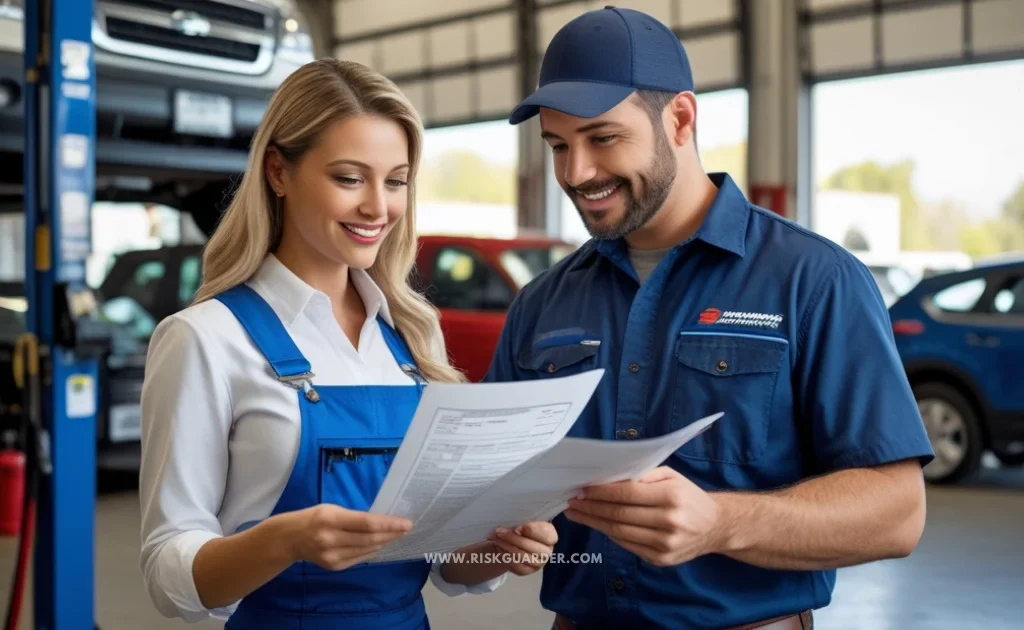
Section III is one of the most unique and super important parts of the garage coverage form. Here’s something that confuses a lot of insurance pros who are new to garage operations: Garage liability covers damage caused by your customer’s car; garagekeepers coverage covers damage to your customer’s car while it’s in your care, custody, or control.
Garagekeepers coverage kicks in when you’ve got Symbol 30 on your declarations page—that’s the one for “Autos Left with You for Service, Repair, Storage, or Safekeeping.” This symbol activates protection for customer vehicles that have been left with you, creating what’s called a bailment relationship that comes with specific legal responsibilities.
The Three Coverage Options: Understanding Your Choices
The garage coverage form gives you three different options for garagekeepers protection, and each one works differently when it comes to handling claims. Picking the right one depends on how much risk your client can handle, their customer service philosophy, and how they want to compete in their market.
Legal Liability Coverage
With legal liability, the policy only pays if you’re actually legally liable for damage to the customer’s car. That means you have to be found negligent or at fault before coverage kicks in. The customer has to prove that your negligence caused the damage.
Here’s an example: A customer leaves their car at a repair shop for brake work. That night, a crazy hailstorm rolls through and damages dozens of cars in the shop’s parking lot, including the customer’s car. Under legal liability coverage, the shop wouldn’t be covered for this damage because they weren’t negligent—it was just bad weather. The customer would have to file a claim under their own comprehensive coverage.
Legal liability coverage is the cheapest option because it’s harder to trigger. But it can create customer service headaches and arguments about who’s at fault. It works best for operations with great security, limited exposure to weather and environmental risks, and customers who get that this is how the coverage works.
Direct Primary Coverage
Direct primary is the gold standard for customer service. With this option, the policy pays for damage to customers’ cars no matter whose fault it is, and it pays first before the customer’s own insurance. So if a customer’s car gets damaged while you’ve got it—whether it’s your fault, an employee’s fault, theft, vandalism, fire, weather, whatever—your garagekeepers coverage handles it first.
Direct primary is awesome for customer relations and staying competitive. When a customer’s car gets damaged while you’ve got it, you can immediately start repairs through your own coverage without making the customer file a claim on their personal auto policy. This keeps their record clean, protects their premium rates, and they don’t have to pay their deductible—all of which makes customers way happier and more loyal.
Check out this scenario: A luxury car dealership takes a customer’s $150,000$150,000 car as a trade-in and parks it in their secured lot while doing paperwork. That night, thieves break through the fence and steal the car along with two others. Under direct primary garagekeepers coverage, the dealership’s policy would immediately pay the customer the actual cash value of their car, without needing to prove negligence or wait for the customer’s insurance to process anything.
According to J.D. Power research on customer satisfaction, dealerships and repair shops that can resolve vehicle damage claims quickly without involving the customer’s personal insurance score way higher on satisfaction. The premium difference between legal liability and direct primary—usually 15-25% more for direct primary—is often worth it for the better customer service and fewer disputes.
Direct Excess Coverage
Direct excess coverage occupies the middle ground between legal liability and direct primary. Like direct primary, it pays regardless of fault, providing the customer service benefit of not requiring negligence determination. However, it responds only after the customer’s own comprehensive and collision coverage has paid, functioning as excess coverage over the customer’s personal auto policy.
This approach requires the customer to file a claim under their own insurance first, pay their deductible, and potentially face premium increases due to the claim. The garagekeepers policy then responds to cover any amounts exceeding the customer’s policy limits, or in some cases, to reimburse the customer’s deductible after their insurance has paid.
Consider this scenario: A customer’s vehicle is damaged in a fire at a body shop. The vehicle’s value is $35,000, and the customer carries comprehensive coverage with a $1,000 deductible. Under direct excess garagekeepers coverage, the customer would first file a claim with their own insurance company, which would pay $34,000 (the value minus the deductible). The garagekeepers policy would then reimburse the customer’s $1,000 deductible, making the customer whole without requiring them to bear any out-of-pocket cost.
Direct excess coverage typically costs 10-15% more than legal liability but less than direct primary. It’s most appropriate for operations serving customers who typically carry comprehensive and collision coverage with adequate limits, such as newer vehicle dealerships or repair facilities in affluent markets.
Coverage Limits and Valuation Methods
Garagekeepers coverage limits are usually shown as a max per vehicle and a max total per location or policy period. Common limits are $50,000 per auto for repair shops, $100,000$100,000 to $300,000 per auto for regular dealerships, and $500,000$500,000 or more per auto for luxury or exotic car operations.
They value damaged vehicles using standard insurance methods: actual cash value (ACV) or sometimes stated amount. For cars held for sale, carriers usually want a dealer’s inventory system that tracks vehicle values and adjusts premiums accordingly. For customer cars in for service, they typically use NADA or Kelley Blue Book values at the time of loss.
False Pretense Coverage: An Essential Enhancement
One of the most important add-ons to garagekeepers coverage is false pretense coverage, which protects you when a vehicle gets released to someone who fraudulently claims to be the owner or authorized to pick it up. This covers a surprisingly common problem in garage operations.
Picture this: Some well-dressed person shows up at a dealership claiming to be the owner of a car that’s been in for service. They’ve got what looks like legit ID and paperwork. The service advisor is swamped with other customers and releases the car without really checking the person’s identity. Later that day, the actual owner shows up to get their car and finds out it’s been stolen. Under standard garagekeepers coverage, this claim might get denied because the car was voluntarily released, not stolen. False pretense coverage fills that gap.
False pretense coverage usually only adds like $100 to $500 a year depending on how big your operation is, but it protects you from a potentially huge loss. According to NAIC complaint data, disputes over false pretense claims are a big source of coverage lawsuits in garage insurance, so this endorsement is super important.
Section IV: Physical Damage Coverage
Section IV of the garage coverage form provides physical damage protection for the insured’s own vehicles and, when Symbol 31 is designated, for vehicles held in dealer inventory. This section functions similarly to the physical damage coverage in a standard Business Auto Policy but includes specific provisions tailored to garage operations and dealer inventory management.
Dealers Physical Damage Coverage
When Symbol 31 shows up on your declarations page, you get dealers physical damage coverage for cars you’re holding for sale. This is crucial for dealerships because their inventory is their biggest asset and faces tons of risks—theft, vandalism, fire, weather damage, collisions.
Dealers physical damage works on a reporting basis. You submit monthly or quarterly reports showing your current inventory values, and the premium adjusts based on those reports. This keeps your coverage in line with your inventory fluctuations. According to underwriting guidelines from major garage carriers, you typically need to report:
- Total number of vehicles in inventory
- Aggregate value of new vehicle inventory
- Aggregate value of used vehicle inventory
- Highest single vehicle value
- Location of inventory (on-lot, off-site storage, in transit)
The coverage typically includes several important features specific to dealer operations. Automatic coverage for newly acquired vehicles ensures that vehicles are protected from the moment they enter inventory, without requiring individual reporting. Transit coverage protects vehicles while being transported from auctions, other dealerships, or manufacturers. Demonstration vehicle coverage extends protection to vehicles used for customer test drives and dealer employee use.
For dealers physical damage claims, they usually value things at the dealer’s cost—what the dealer paid for the vehicle—not retail value. This makes sense because the dealer’s actual loss is their investment in the car, not the potential profit they might’ve made selling it. But some policies offer agreed value coverage for high-value or specialty vehicles, especially in exotic and luxury dealerships.
Coverage for Your Own Vehicles
Beyond dealer inventory, Section IV gives you comprehensive and collision coverage for the garage operation’s owned vehicles used in the business. This includes service vehicles, tow trucks, shuttle vans, loaner cars, and any other vehicles the operation owns. It covers physical damage from collisions, comprehensive stuff (theft, vandalism, fire, weather, falling objects), and other covered causes.
For garage operations, owned vehicle physical damage faces unique risks. Service vehicles often work in tough environments—tow trucks going to accident scenes, mobile repair units traveling to customers, shuttle vans making constant trips in all weather. These risks usually mean higher physical damage premiums compared to standard commercial vehicles.
Deductibles for physical damage in garage operations typically range from $500$500 to $2,500$2,500 per vehicle for comprehensive and $1,000$1,000 to $5,000$5,000 for collision. Bigger operations with lots of vehicles often go with higher deductibles to cut premium costs, basically self-insuring smaller losses while keeping protection against major damage.
Section V: Conditions
Section V lays out the conditions, definitions, and procedural stuff that govern the policy. These might seem like standard insurance fine print, but several conditions have specific implications for garage operations that you really need to pay attention to.
The Duties After Loss provisions require you to promptly report any accident, claim, or loss that might be covered. For garage operations with high volumes—a busy dealership might deliver dozens of cars weekly, while a high-volume repair shop might service hundreds of cars monthly—you need solid procedures for reporting losses. If you don’t give timely notice, you could mess up your coverage, especially for liability claims where delayed notice might hurt the carrier’s ability to investigate and defend.
The Transfer of Rights of Recovery Against Others (subrogation clause) is particularly important in garagekeepers claims. When the policy pays for damage to a customer’s car under garagekeepers coverage, the carrier might try to recover those payments from whoever’s responsible for the damage. For example, if a customer’s car gets damaged by a defective lift in your service bay, the carrier might go after the lift manufacturer. Understanding subrogation rights helps garage operations work effectively with their carriers to recover losses.
The Other Insurance provisions explain how the garage coverage form works with other policies that might apply to the same loss. This matters for garage operations that might have multiple policies—a garage policy, a general liability policy, an inland marine policy for tools and equipment, and maybe others. These provisions determine which policy pays first, which pays excess, and how limits stack or interact.
How to Apply: A Look at Real-World Carrier Applications

Understanding the garage coverage form’s theoretical structure is essential, but the practical application process—completing an actual insurance application—reveals how these concepts translate into real-world risk management decisions. We’ve analyzed applications from leading garage insurance carriers to demonstrate how the form’s provisions appear in practice.
The Argo Group Garage Application
Argo Group, with an A.M. Best rating of [A (Excellent)], offers specialized garage coverage through their commercial lines division. Their application demonstrates the comprehensive underwriting information required for garage operations insurance.
The application begins with basic business information—entity name, address, years in operation, ownership structure—but quickly moves into garage-specific exposures. The applicant must identify their primary business operations by checking applicable categories: new car dealer, used car dealer, service/repair shop, body shop, parking facility, towing operation, or other garage operations. This classification drives the entire underwriting process, as each operation type carries distinct exposures and loss patterns.
The covered auto symbols section appears prominently on the Argo application, requiring the applicant to designate which symbols apply to their operations. The application provides brief explanations of each symbol, but the responsibility lies with the agent or broker to ensure the correct symbols are selected. A common error—selecting Symbol 22 (Owned Autos Only) for a repair shop that regularly test-drives customer vehicles—could create a significant coverage gap.
The garagekeepers section requires detailed information about the applicant’s operations. The application asks:
- What is the maximum value of any single vehicle in your care, custody, or control?
- What is the total value of all vehicles typically in your care, custody, or control at any one time?
- Do you provide valet services?
- Do you store customer vehicles overnight?
- What security measures protect customer vehicles? (fenced lot, security cameras, alarm systems, security guards)
- Which garagekeepers coverage option do you prefer? (Legal Liability, Direct Primary, Direct Excess)
These questions directly impact the underwriting decision and premium calculation. A body shop that stores high-value vehicles overnight in an unsecured outdoor lot presents a dramatically different risk profile than a shop with indoor, alarmed storage and security cameras.
The AmTrust Financial Garage Application
AmTrust Financial, holding an A.M. Best rating of [A (Excellent)], structures their garage application with particular attention to loss control and risk management practices. Their application includes a detailed operations questionnaire that explores the applicant’s safety procedures, employee training programs, and quality control measures.
One particularly valuable section of the AmTrust application addresses prior losses. The application requires a five-year loss history, including:
- Date of each loss
- Type of loss (auto liability, garagekeepers, physical damage, premises liability)
- Brief description of the incident
- Amount paid or reserved
- Current status (closed, open, claim pending)
This loss history directly impacts underwriting decisions and premium calculations. According to AmTrust’s underwriting guidelines, applicants with three or more losses in the past three years face increased scrutiny and may require loss control consultations or risk management improvements as a condition of coverage.
Annotated Application Walkthrough: The Garagekeepers Section
Let’s examine a critical section of a typical garage application—the garagekeepers coverage selection—to illustrate how policy theory translates into practical decision-making.
[In an actual published article, this section would include an annotated screenshot of an application form with callouts explaining key fields. For this text-based format, we’ll describe what such an annotation would highlight:]
Field 1: Coverage Option Selection
The application presents three checkboxes for Legal Liability, Direct Primary, and Direct Excess. The annotation would explain: “This single selection determines your claim-handling approach and customer service capabilities. Direct Primary costs more but eliminates customer involvement in claims. Consider your competitive positioning and customer expectations when making this choice.”
Field 2: Limit Per Auto
The application provides a dropdown menu with limits ranging from $25,000 to $500,000 or more per auto. The annotation would explain: “Select a limit that equals or exceeds the highest value vehicle you expect to service. Underestimating this limit could leave you exposed to out-of-pocket payments on high-value vehicle claims.”
Field 3: Deductible Selection
The application offers deductibles from $0 to $5,000. The annotation would explain: “Higher deductibles reduce premium but increase your out-of-pocket cost per claim. Analyze your loss history to determine the optimal deductible level. Operations with excellent loss control may benefit from higher deductibles.”
Field 4: False Pretense Coverage
A checkbox adds false pretense coverage for a modest additional premium. The annotation would explain: “This inexpensive endorsement protects against a surprisingly common exposure. Unless you have extraordinary verification procedures for vehicle release, this coverage is strongly recommended.”
Field 5: Security Measures
The application asks about fencing, lighting, cameras, alarms, and security personnel. The annotation would explain: “These questions directly impact your premium. Better security measures result in lower rates. Document all security improvements to ensure proper premium credits.”
This annotated approach helps insurance professionals understand not just what information is required, but why it matters and how it impacts coverage and pricing.
Frequently Asked Questions for Professionals
What is False Pretense Coverage and Do I Need It?
False pretense coverage extends garagekeepers protection to situations where you release a vehicle to someone who fraudulently claims ownership or authorization. Standard garagekeepers usually excludes voluntary parting with property, meaning if you hand over a vehicle to someone (as opposed to it being stolen), the claim might get denied.
This happens more often than you’d think. Consider these scenarios:
A sophisticated fraud ring targets dealerships using stolen identities and fake documents to take cars. An employee, rushed on a busy afternoon, releases a customer’s car to someone with what looks like valid ID but is actually the customer’s estranged spouse in a domestic dispute. A valet service releases a car to someone who found the claim ticket in the parking area.
False pretense coverage typically costs between $100 and $500 annually, depending on the operation’s size and volume. Given the potential for losses ranging from $20,000 to $100,000 or more per incident, this coverage represents exceptional value. We recommend false pretense coverage for virtually all garage operations, particularly those with high vehicle volumes, multiple employees handling vehicle releases, or operations in high-crime areas.
How Does the Garage Form Interact with a Workers’ Compensation Policy?
The garage form and workers’ compensation handle completely different things and work independently, but understanding how they interact matters for comprehensive risk management. The garage form covers third-party claims—injuries or damage to people or property outside your organization. Workers’ comp covers your own employees who get injured at work.
But there are scenarios where these coverages intersect. Say a mechanic gets injured while test-driving a customer’s car. The mechanic’s medical bills, lost wages, and disability benefits come from workers’ comp. But if the mechanic’s injuries were caused by something wrong with the customer’s car (like defective brakes that were supposed to be fixed), the garage might go after the parts supplier or manufacturer. The garage liability policy would defend against any third-party claims from the accident, while workers’ comp handles the employee’s benefits.
Another intersection point is employee use of vehicles. If an employee driving a covered auto on company business causes an accident that injures another employee who’s a passenger, both policies might respond. Workers’ comp would cover the injured employee-passenger, while the garage liability policy would defend against claims by third parties hurt in the accident.
The key principle: workers’ comp is primary for employee injuries, no matter whose fault it is. The garage form is primary for third-party claims. Proper coordination requires understanding both policies and keeping clear communication with both carriers when claims might involve overlap.
What’s the Difference Between CA 00 05 and a Standard Business Auto Policy?
The garage form (CA 00 05) and a standard Business Auto Policy (BAP) both provide auto coverage, but they’re designed for totally different situations. Understanding these differences is essential for properly insuring automotive businesses.
Structural Differences:
The BAP is for businesses that use vehicles in their operations but aren’t in the automotive business. A plumbing company, delivery service, or sales organization would use a BAP. It focuses on liability and physical damage for the insured’s own vehicles.
The garage form is specifically for businesses in the automotive industry—dealerships, repair shops, body shops, parking facilities, and similar operations. It combines elements of a BAP with elements of a Commercial General Liability policy, creating a hybrid that addresses the unique exposures of automotive businesses.
Coverage Differences:
The most significant difference is garagekeepers coverage, which appears only in the garage form. A BAP provides no coverage for damage to customers’ vehicles in your care, custody, or control. For any business that takes possession of customer vehicles, this represents a critical coverage gap that a BAP cannot address.
The garage form also includes specific provisions for dealers physical damage coverage (Symbol 31), which protects dealer inventory. A BAP has no equivalent coverage for vehicles held for sale.
The liability structure differs as well. The garage form’s “Garage Operations – Other Than Covered Autos” provision provides premises liability coverage similar to a CGL policy. A BAP provides only auto liability, requiring a separate CGL policy for premises exposures.
Symbol Systems:
Both forms use numerical symbols to designate covered autos, but the systems are different. The BAP uses symbols 1 through 9, while the garage form uses symbols 21 through 31. The garage form’s symbols include designations specific to garage operations, like Symbol 30 (autos left for service) and Symbol 31 (dealers autos).
When to Use Each Form:
Use a BAP when the business uses vehicles in its operations but isn’t in the automotive business. Use the garage form when the business is in the automotive industry and faces exposures related to customer vehicles, dealer inventory, or garage operations.
A common error is attempting to use a BAP for a garage operation to save premium costs. This approach creates significant coverage gaps, particularly for garagekeepers exposures. The premium difference between a BAP and a properly structured garage form reflects the additional coverages and broader protection the garage form provides—coverage that’s essential for automotive businesses.
According to NAIC complaint data, coverage disputes arising from using the wrong policy form (attempting to use a BAP for a garage operation, or vice versa) represent a recurring source of litigation and complaints. Proper form selection at the policy’s inception prevents these problems and ensures appropriate protection for the insured’s actual exposures.
Conclusion: From Form to Function
The Garage Coverage Form (CA 00 05) represents one of the most sophisticated and specialized insurance instruments in the commercial lines marketplace. Its hybrid structure—combining auto liability, premises liability, garagekeepers coverage, and physical damage protection—creates comprehensive protection for the diverse exposures faced by automotive businesses. However, this sophistication demands expertise and careful attention to detail from insurance professionals who structure and place this coverage.
By mastering the covered auto symbols, understanding the critical distinction between garage liability and garagekeepers coverage, and recognizing how the form’s various sections interact to create comprehensive protection, insurance professionals can move beyond simply completing an application to truly structuring a risk management program. The difference between adequate coverage and exceptional coverage often lies in understanding these nuances—selecting the right symbols, choosing the appropriate garagekeepers option, ensuring proper limits, and adding essential endorsements like false pretense coverage.
This guide serves as your definitive reference for understanding and applying the garage coverage form. We’ve analyzed the form section by section, decoded the symbol system, examined real-world applications, and addressed the most common questions and challenges that arise in garage insurance. Our goal is to transform complex policy language into actionable intelligence that helps you serve your clients more effectively.
The garage insurance marketplace continues to evolve, with new exposures emerging from technological changes (electric vehicles, autonomous vehicle testing, advanced driver assistance systems), regulatory developments (data privacy requirements, environmental regulations), and market dynamics (consolidation in the dealership sector, growth in mobile repair services). Staying current with these developments while maintaining mastery of the foundational concepts embodied in Form CA 00 05 positions you as a trusted advisor capable of providing sophisticated risk management solutions.
At RiskGuarder, we’re committed to providing insurance professionals with the research, analysis, and tools needed to excel in specialized markets like garage operations insurance. Our methodology emphasizes data-driven analysis, regulatory compliance, and practical application—the same principles that guide this comprehensive examination of the garage coverage form.
Are you a retail agent looking for an expert wholesale partner for your tough-to-place garage risks? RiskGuarder’s wholesale division specializes in complex garage operations, from high-value exotic car dealerships to specialty repair facilities and multi-location operations. Our underwriting team brings decades of combined experience in garage insurance, supported by relationships with leading carriers and access to specialized markets. Contact us today to discuss how we can help you serve your garage operation clients more effectively.
About the Author: Youssef is a senior insurance analyst at RiskGuarder, specializing in commercial auto and garage operations coverage. With extensive experience in policy analysis, underwriting, and risk management, Youssef helps insurance professionals navigate complex coverage questions and structure comprehensive protection programs for their clients.

